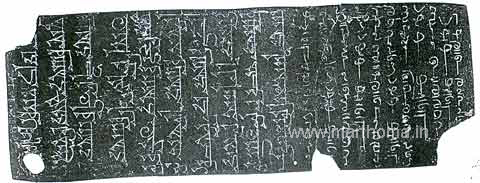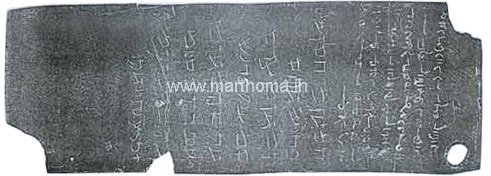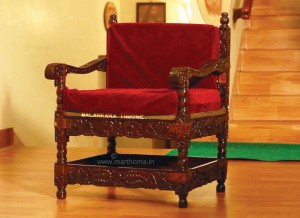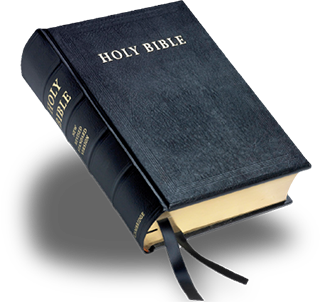The history of the Mar Thoma Church is divided into three main eras:
- Pre-Reformation
- Reformation
- Post Reformation
Pre-Reformation Era
The seven churches were:
- Cranganore (Malankara)
- Chavakad (Palur)
- Parur near Alwaye
- Gokamangalam
- Niranam
- Nilakkal (Chayal)
- Quilon (Kalyan)
“You may be surprised to learn that Christianity came to India long before it went to England or Western Europe, and when even in Rome it was a despised and proscribed sect. Within 100 years or so of the death of Jesus, Christian Missionaries came to South India by sea. They were received courteously and permitted to preach their new faith. They converted a large number of people, and their descendants have lived there, with varying fortune, to this day. Most of them belong to old Christian sects which have ceased to exist in Europe.”
Chepped-I kept in the Marthoma Church Head Quarters Thiruvalla

Chepped-II kept in the Marthoma Church Head Quarters Thiruvalla: Side 1

Chepped-II kept in the Marthoma Church Head Quarters Thiruvalla: Side 2

MALANKARA THRONE

But that was not the end. There was a nucleus of people in the church who longed for the removal of unscriptural customs and practices which had crept into the church over the centuries. They envisioned a reformation in the Church in the light of the Gospel of our Lord. There were two outstanding leaders in this group, one was Palakunnathu Abraham Malpan of Maramon (1796-1845) and the other, Kaithayil Geevarghese Malpan of Puthuppally (1800-1855). Both were teachers in the Syrian Seminary (established in AD 1813 by Pulikottil Mar Dionysius) and had opportunities to come into close personal contact with the missionaries and to share their insights regarding the Christian life and the nature and functioning of the Church as depicted in the New Testament and to imbibe the ideas of the Western Reformation. The group led by these two was very much concerned about the need of a revival in the Church.
Reformation Movement
Palakkunnathu Abraham Malpan from Maramon and Kaithayil Geevarghese Malpan from Kottayam who spearheaded this movement, never wanted to start a separate Church. They wanted the reformation, staying within the Church. This group gradually became vocal and approached Col. Fraser, the British Resident, with a memorandum in 1836 . But since nothing came of it, Abraham Malpan decided to take action in his own parish of Maramon which was sympathetic towards his ideas of reform. He translated the liturgy of the Holy Qurbana into local language Malayalam from Syriac and also eliminated from it the prayers for the dead and invocation of saints etc. He celebrated Holy Qurbana in his church using the revised St.James liturgy on a Sunday in 1836. This was tantamount to firing the first shot of the reformation. He later on removed from the church the wooden image of a saint reputed to have miraculous powers, and in whose honor an annual festival was held that brought in huge income to the Parish. Both at Maramon and at the Syrian Seminary at Kottayam, and in the neighboring Parishes of Pallom and Kollad, Abraham Malpan popularized Bible teaching and preaching. Abraham Malpan and Geevarghese Malpan had to give up their service in the Seminary, in 1840. Since then Abraham Malpan concentrated his attention on the work of reform, holding Bible classes and prayer meetings and instructing the deacons who were loyal to him.
:Most prominent elements in the Reformation were
- Return to the gospel message of salvation by faith in Jesus Christ;
- Cleansing of wrong ways of life, and
- Taking up responsibility to be witnesses of Jesus Christ to other;
- All importance be given to the primacy of the Word of God.
Post Reformation
The Church has now 1246 parishes including congregations, divided into thirteen dioceses. There are 11 Bishops including the Metropolitan and 925 active priests (and 224 retired priests). It has a democratic pattern of administration with a representative assembly (Prathinidhi Mandalam), an executive council (Sabha Council) and an Episcopal Synod.
The Church has social welfare institutions, destitute homes and Hospitals. The Mar Thoma Tehological Seminary (Estd: in 1926) and other Theological Institutescater to the theological education of both the clergy and the laity. Further, there are Study Centres, for arranging regular study programmes and to provide opportunities for creative dialogue between church and society on various ethical, moral, social and religious issues. The religious education of children is looked after by the Christian Education Department – the Sunday School Samajam (organized in 1905) and the work among youth is carried on by the Youth Department – the Yuvajana Sakhyam (organized in 1933). The Church has a women’s department – the Mar Thoma Suvisesha Sevika Sanghom (organized in 1919) which is vigorously active.

